We are now 35 weeks — 244 days — since Russian President Vladimir Putin “unleashed the hounds,” so to speak. My last update was over the weekend; even though not a lot has happened, I’m trying to reduce the length of the updates by making them more frequent.
Politico-Strategic Level
Russia’s Dirty-Bomb-False-Flag Gambit Fizzles
Over the weekend and early in the week, Russia’s Defense Minister and Foreign Minister floated the allegation that Ukraine was building one or more “dirty bombs.” The claim was that Ukraine planned to detonate those weapons, blame Russia for the attack, and draw NATO into the fray in retaliation. It was also seen as a predicate for Russia to use a tactical nuclear weapon in retaliation. Some of the campaign was executed in a way that leads one to believe that even the Russians weren’t taking the claim all that seriously.
Russia created another fabrication regarding the “dirty bomb” false flag operation. They used pictures of the Slovenian nuclear disposal site and claimed that it is Ukrainian. The Slovenian response was swift and clear: Russian lie.#Ukraine #Russia #Slovenia pic.twitter.com/Sj6ks41sn6
— (((Tendar))) (@Tendar) October 26, 2022
As I reported in Russia’s ‘False Flag Dirty Bomb Attack’ Gambit Is Laughed at by Everyone, That Doesn’t Mean They Won’t Do It; no one bought it. There were no takers even when Putin made the case.
We know Putin approached China and India with the claim. We don’t know how China reacted, but India was not sympathetic (Putin Ally Shuts Down Russia’s Claim Ukraine Plans to Unleash Dirty Bomb).
As I’ve said before, none of this means Russia can’t launch the “faux” false flag operation; it just means that no one is going to take Russia’s word.
From Atom Bomb to Dirty Bomb to Anti-Satellite Warfare
From the first days of the war, Russia has threatened Ukraine and the West with all manner of bad things. It is widely acknowledged that US and western military and commercial satellites provide critical operational and targeting data to Ukraine. Russia has satellites, too, but it doesn’t seem to have a clear doctrine on how to use its product to support combat operations. When feeling the pinch, the Russians fall back to the Khruschev response of beating their shoe on the tabletop.
#Russian Foreign Ministry spokesman Konstantin Vorontsov threatens to shoot down Elon #Musk's #Starlink satellites, as well as the satellites of Planet Labs and Maxar, which create detailed images of different areas. pic.twitter.com/tlbNMtldq5
— NEXTA (@nexta_tv) October 27, 2022
In response to Russian Foreign Ministry official Konstantin Vorontsov’s threats to shoot down commercial satellites helping Ukraine, John Kirby, US National Security Council coordinator for strategic communications, said no attack on US infrastructure would go unanswered. pic.twitter.com/LkaLdmSvx6
— NOËL 🇪🇺 🇺🇦 (@NOELreports) October 27, 2022
Russia Adds New Goal for Ukraine War
The war started out with the objectives of de-Nazifying and demilitarizing Ukraine, ensuring Ukrainian neutrality, and confirming the independence of the Russian-occupied Donbas. Since then, we’ve seen four Ukrainian oblasts annexed and implications by Putin that Ukraine must cease to exist as a nation. So now we have a new one: Exorcism.
Statement of Assistant Secretary of 🇷🇺 Security Council Pavlov about "desatanization" of Ukraine continues the almost as absurd line of "demilitarization" and "denazification." Russian propaganda has long been insisting on the imaginary pervasiveness of cults in Ukraine. 1/3 pic.twitter.com/TrLIIvWy8X
— Stratcom Centre UA (@StratcomCentre) October 26, 2022
Friction Between Poland and Kaliningrad Heats Up
Russia has retained possession of an enclave on the Baltic after the dissolution of the USSR. To function, this territorial anomaly relies upon the goodwill of Poland and the Baltic States. That hasn’t always been forthcoming, Lithuania Enforces EU Sanctions on Kaliningrad and Putin’s Toadies Lose Their Minds.
Now the Russian authorities have announced that they are opening flights to Kaliningrad from Africa, Asia and the Middle East. The Polish authorities believe that in this way the Kremlin wants to organize another migrant crisis at the border in the coming weeks.
/2
— Lew Anno Yieretz Israel (@anno1540) October 25, 2022
Why would Poland be concerned about this? Because Belarus has used illegal immigration to try to destabilize Poland. Hence the wall between the two countries.
#Belarus Border guards seem to be really enjoying their business of helping migrants cross the border with the EU. This video was shared by #Poland’s State Border Control. There is now less attention to this weaponisation of migration by the regime but it is still happening pic.twitter.com/NRtbppEgIk
— Hanna Liubakova (@HannaLiubakova) October 27, 2022
Iran Sends Advisors to Belarus
In my last update, Putin’s War, Week 34. False Flags, Martial Law, and ‘Dammed if You Do and Dammed if You Don’t,’ I reported on Iranian advisors appearing in Ukraine. Most are undoubtedly associated with Russia’s purchase of Shahed-136 suicide drones. It is probably safe to assume they are involved in other things, too. Now Iranian advisors have been reported in Belarus.
📰 via @Jerusalem_Post:
Instructors from Iran’s Islamic Revolutionary Guard Corps (IRGC) are training Russian forces in Belarus and coordinating the launches of Iranian-made drones, according to the Ukrainian National Resistance Center.https://t.co/WKAJ2U9gLt— FDD's Iran Program (@FDD_Iran) October 25, 2022
The implication is that Russia is about to launch suicide drones from Belarus, bypassing the relatively dense air defense system on Ukraine’s eastern frontier. We don’t know if the advisors are training Russians or if Belarus will launch the attacks in its own right. Another possibility is that Iran will launch the missiles from Belarus in its role as a Russian ally.
Belarus Takes the Lead in Training Russian Soldiers
I’ve posted several times on two aspects of Russia’s military that are proving inadequate for this war. Russia does not have a training base in the sense that Western militaries do. Russian contract and conscript soldiers receive cursory training before posting to a unit. Most of their training takes place in an on-the-job training environment in the unit. The Russian Army does not have a long-serving professional noncommissioned officer corps and relies upon its officers to act as the primary trainer of soldiers and small units. The Russian Army officer corps has been mauled in Ukraine (for the latest documented body count of Russian officers, visit this site.) This means there is a lack of trainers in units currently in the fight and in those being formed from scratch.
The solution to at least part of the problem is to use officers from the Belarus Army as trainers.
TRANSLATION :
⚡️ In the occupied part of Zaporizhzhia region there are military men of the Republic of Belarus, – the mayor of Melitopol Ivan Fedorov"On the territory of the city of Melitopol ther
Source : https://t.co/MLqJEDCSve
Media link : https://t.co/THoZAwMiNc— BenB 🌻🇺🇦 (@benbvi3ws) October 25, 2022
Belarus-Ukraine Face-Off Continues
Last update I posted about the low-grade mobilization effort in Belarus and the possibility that Belarus would open a “second front” in the war. I think the danger of this is minimal, but Ukraine has to plan based on capabilities rather than intention, and so the recent belligerence by Belarus has frozen some Ukrainian forces in place.
BREAKING: Ukraine confirms that it has increased its military presence near Belarus's borders
— Samuel Ramani (@SamRamani2) October 27, 2022
The two nations are engaged in a war of words.
The Ukrainian Army has released a video to the people of Belarus.
It says the 2 nations have always had good relations and fought side-by-side in many wars.
The Ukrainians say Lukashenko is a criminal & that Ukraine will fight back if Belarus invades UA. pic.twitter.com/XDFMsjAqcN
— Visegrád 24 (@visegrad24) October 23, 2022
Belarus responds to Ukraine, “If you do not want war, there won't be one. But do not provoke us, do not try to intimidate us, do not escalate and things will be as you want. We do not want war and threaten no one. However, we will respond to any challenges and provocations.” pic.twitter.com/THKGxYOcSM
— Nina 🐙 Byzantina (@NinaByzantina) October 26, 2022
And some new Belarus equipment is on display.
Belarus just invented the cope bucket to 'protect' MBTs against munitions fitted with IR seekers 🇧🇾
This is real.
I'm not joking. pic.twitter.com/VIEwl9MJYA
— Oryx (@oryxspioenkop) October 27, 2022
Maybe Belarus needs to worry less about Ukrainian Anti-Tank weapons and worry more about their wooden vehicle armor. https://t.co/ghjyT2FA2B pic.twitter.com/rcfaCpRbkL
— CJ (@CasualArtyFan) October 27, 2022
Russian Rumored to Recruit US-Trained Afghan Commandos
New: Members of Afghanistan’s former elite army commando corps say they are being contacted with offers to join the Russian military to fight in Ukraine https://t.co/GV5ctwbaLN from @lynnekodonnell
— Robbie Gramer (@RobbieGramer) October 25, 2022
Mobilization Spins Out of Control
The mobilization situation has not improved (read the whole thread).
7/ In this second video, men from Bashkortostan who have been deployed to the south in the Zaporizhzhia region complain of very similar problems. They say they were "sent to the fields, where people have no water, nothing to drink, no food."pic.twitter.com/wpgWNECqJa
— ChrisO (@ChrisO_wiki) October 25, 2022
Russian media reported that mobilized men in the Belgorod region are rebelling because of terrible conditions, lack of food and roof, and that they were given decommissioned weapons. In the videos, they claim that among 500 new drafters many got cold, weren’t assigned to any unit pic.twitter.com/AGt1ZaIpOw
— Hanna Liubakova (@HannaLiubakova) October 5, 2022
Shooting Range Training for mobiks.
With no weapons.
Everyday this russian army is going deeper in Nonsense & WTF.#OnlyInRussia pic.twitter.com/3zowoBkr9l— cedric mas (@CedricMas) October 28, 2022
Iran is helping Russia to cope with equipment shortages.
Mobilized Russians began to be provided with body armor and helmets of Iranian production, – GUR,
According to the GUR, the transfer of 3,000 units of armor protection is planned in the near future. Half of them are bulletproof vests pic.twitter.com/e0hUXzjDYn
— ТРУХА⚡️English (@TpyxaNews) October 24, 2022
Oddly enough, some part of this may be due to mobilization officers being overly aggressive and more than the target number of 300,000 being scooped up.
In Russia, you need to apply for a marriage registration 1 month in advance. However, with a mobilization notice, you could register the same day. The article assumes that the excess marriages of the last 4 weeks are those who were living together yet were not registered. 2/ pic.twitter.com/QKsEHVfLzE
— Konstantin Sonin (@k_sonin) October 24, 2022
If the goal of 300K has been exceeded by 66%, this could easily account for the stories of troops without tents, uniforms, weapons, or food.
On pro-Russian sites, there is a lot of talk about how this wave of mobilized men will turn the tide. Charitably, that assessment is bullsh**. The Russian Army is not producing combat power; it is creating cannon fodder. Likewise, the “winter is coming” nonsense that pro-Russia milbloggers use as a catchphrase for the next phase of the war is not going to work out well. Russia does not have some genetic advantage when fighting during the winter (see Finland, 1939-40). Russian logistics is barely keeping up with the task of sustaining the existing force; it is unlikely that it will be up to supplying cold-weather gear to Russian troops. There is also the persistent lie that Ukraine is sending “human waves” against prepared Russian positions. This is not to say that the Ukrainians win every engagement, but as much video as there is from this war, we’d see ample evidence of profligate waste of ground troops by now.
Ukraine is receiving large quantities of cold-weather clothing and equipment, 500,000 sets from Canada alone, and the NATO training effort is accelerating.
Australia has now joined the UK-led battlefield skills training programme for Ukrainian recruits with little to no military experience.
In total, trainers from nine nations will train Ukrainian recruits across Britain.
🇸🇪🇨🇦🇳🇱🇩🇰🇳🇿🇱🇻🇦🇺🇳🇴🇫🇮
🇺🇦 #StandWithUkraine 🇺🇦 pic.twitter.com/I6II7o8lTU
— Ministry of Defence 🇬🇧 (@DefenceHQ) October 27, 2022
My prediction is that the Ukrainian Army will survive this winter in much better condition than the Russian Army, and though the operational tempo will slow, it will continue to make gains throughout the winter.
Operational Level
Operational Overview
These maps serve two purposes. First, they let you see how the fighting has progressed since February 24, so any subsequent maps can be viewed in context. They also serve as a visual rebuttal to the claim that Russia is gaining ground.
This animation takes you from D-Day through September 24.
This animation begins on August 31 and ends on October 4.
Movement since October 4 has been limited — this is the time of rasputitsa when tracked or wheeled vehicular movement off all-weather roads becomes very challenging — but that may be changing.
New Weapons
SMASH Dragon
The drone has become the unofficial symbol of Putin’s War in Ukraine. They are ubiquitous. Small commercial-off-the-shelf (COTS) drones are everywhere. The Ukrainians have jury-rigged drones to drop munitions. The Iranians have provided suicide drones that are wreaking havoc on civilian infrastructure. Defeating observation drones and swarms of suicide drones can be done, but it can’t be done economically. A drone costing a few thousand dollars requires a missile costing north of $250,000 to knock it down. This has led to the return of the anti-aircraft gun. The German Gepard (see Putin’s War, Week 19. Political Uncertainty, Lots of New Weapons, and a Replay of the Western Front) is establishing a reputation as a formidable anti-drone and anti-cruise missile system. But there are too few of them, and they can’t be diverted from defending critical infrastructure to clearing the skies at the Forward Edge of the Battle Area (FEBA) of observation drones and loitering munitions.
There may be an answer at hand. The Israeli defense company Smart Shooter has sold its SMASH Dragon anti-drone system to Ukraine.
Israeli media reported on the transfer of Smart Shooter complexes installed on UAVs to Ukraine to combat Iranian drones pic.twitter.com/nJ52Ry8wam
— NOËL 🇪🇺 🇺🇦 (@NOELreports) October 26, 2022
The same company makes a ground-station version that turns standard infantry weapons into drone killers.
While its utility against many drones is obvious, you can’t ignore how this could be used to clear trenches or hunt down enemy reconnaissance units or thin-skinned vehicles.
Combat Operations
Combat at Bakhmut
This video of combat near Bakhmut, where Wagner Group and LNR conscripts have been grinding away since July, surfaced. It shows a Ukrainian attack on a Russian defensive position.
Drone filmed Ukrainian soldier eliminating Russian invader in a dugout. pic.twitter.com/uk3FH9p0qT
— WorldOnAlert (@worldonalert) October 26, 2022
The Dangers of Social Media
One of the biggest pro-Russian cheerleaders of the war is the “president” of the Chechen Republic, Ramzan Kadyrov. He has recruited several hundred Chechens to fight in Ukraine.
In this video from #Grozny, #Chechnya, south #Russia, 16-yo son of Chechnya head Ramzan Kadyrov is “gifting” to his father three Ukrainian POWs captured in #Ukraine.
If this is not a theatre but real life situation, this is modern slavery. pic.twitter.com/npI8yBBEp4
— Alex Kokcharov (@AlexKokcharov) October 21, 2022
They seem to be used as the lineal descendants of NKVD “blocking troops,” that is, stationed behind the front lines to “encourage” troops who want to retreat to return to the fight. They also love them some TikTok. A new group of Kadyrov’s Chechens posted a video of their arrival at the front on social media.
40 dead Kadyrovskis and 100 more missing, that is the result after they posted their position on Telegram. Footage shows them before Ukrainians eliminated their base. #Chechnya #Ukraine pic.twitter.com/5DH8UKAEML
— (((Tendar))) (@Tendar) October 26, 2022
The video contained enough data to let Ukrainian artillery target the location.
The Armed Forces of Ukraine struck the base of the TikTok army somewhere in Kherson region. The Kadyrovites (Chechen militants loyal to Putin's Gauleiter, Ramzan Kadyrov) had just arrived in theatre after being mobilized.
At least 40 Kadyrovites were killed, another 60 injured. pic.twitter.com/Au1reeaPbe
— Michael MacKay (@mhmck) October 24, 2022
Kherson
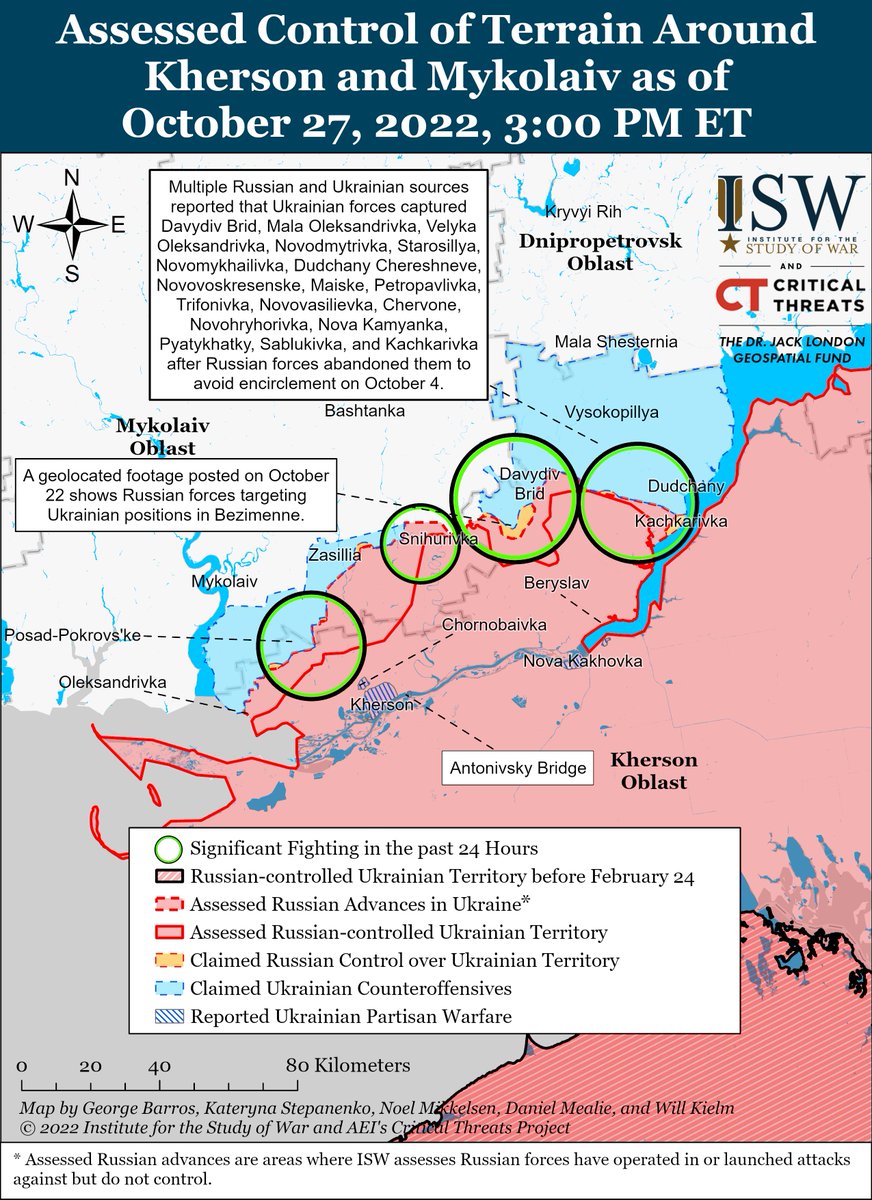
Donbas
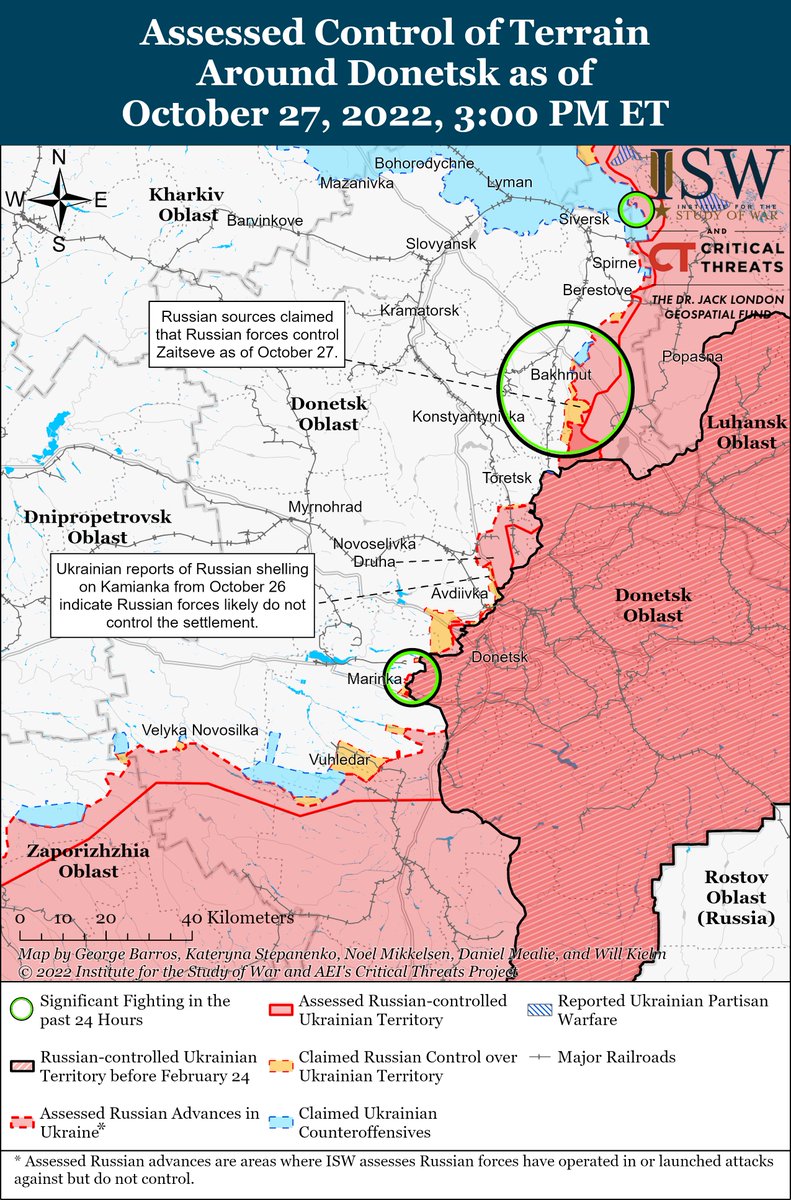
The Russian Army continues with nearly daily assaults in the Bakhmut, Avdivika, and Marinka areas. The frontline remains unchanged.
There has been regular partisan activity in occupied Kherson and Zaporizhzhia since the war began. This is video is of an IED outside occupation television studios. It is thought to be targeting pro-Russian “journalists” in the van.
The moment of today's explosion in Melitopol near the building of Yevgeny Balitsky Russian-appointed Governor of region. (attention to Lada)
/2 pic.twitter.com/8VcJSIQnas— Special Kherson Cat 🐈🇺🇦 (@bayraktar_1love) October 25, 2022
Kharkiv
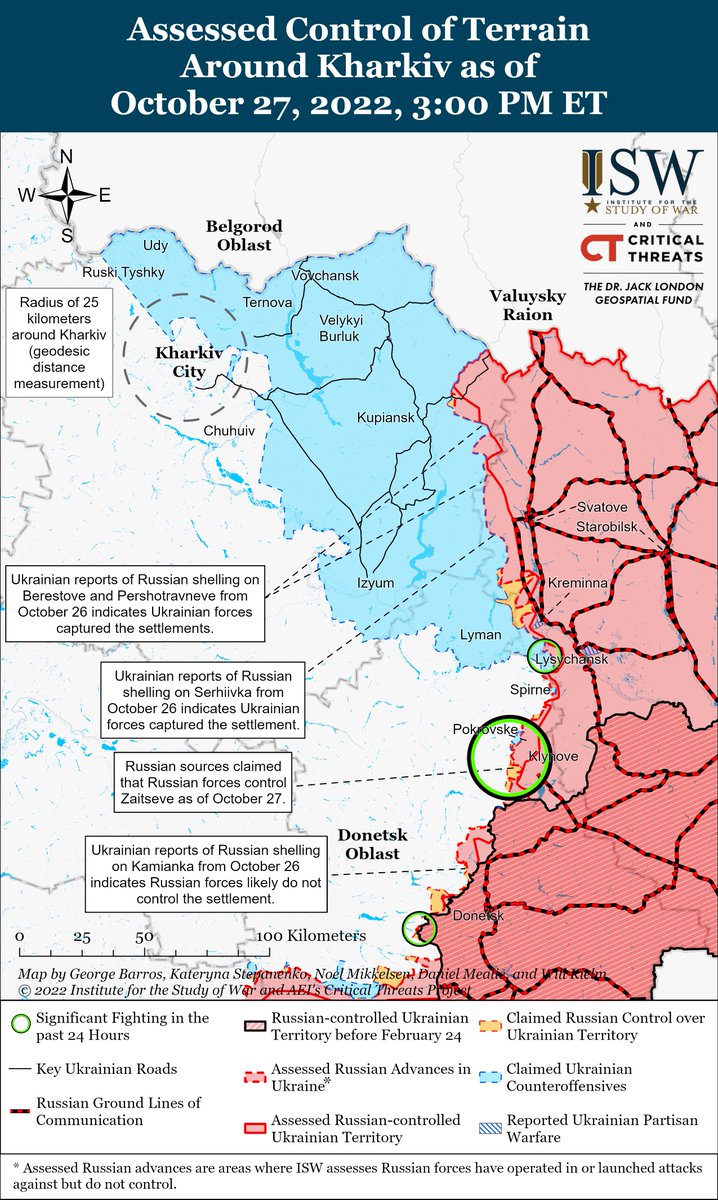
The heaviest fighting is taking place in the Kharkiv area of operations. That fighting is focused around Svatove. The Ukrainians have made minor gains there.
Looking Forward
My assessment is that Russia has ceded initiative on the battlefield to Ukraine; it is concentrating its efforts on fracturing the NATO-led supporting coalition and creating a populist movement in Europe that blames Ukraine for energy prices.
Ukraine has opportunities to attack; the challenge is picking the right battle and having sufficient men and materiel to penetrate the Russian front lines and create breakthroughs at the operational level, as happened in September (Kharkiv) and October (Kherson). Kherson, I think, will largely take care of itself. The majority of the Russian troops are on the right bank of the Dneipr River and dependent on barges, and frequently attacked pontoon bridges for support. Ukraine has nothing to gain from engaging in street-to-street fighting in Kherson when it can wait and force the Russians to abandon the city and countryside.
In Kharkiv, keep an eye on Svatove. A breakthrough there will probably be focused on Starobilsk. If it succeeds, supplying Russian troops south of that point will be very difficult. Finally, look for something big to happen in Zaporizhzhia on the axis Orikhiv-Tokmak-Melitopol.
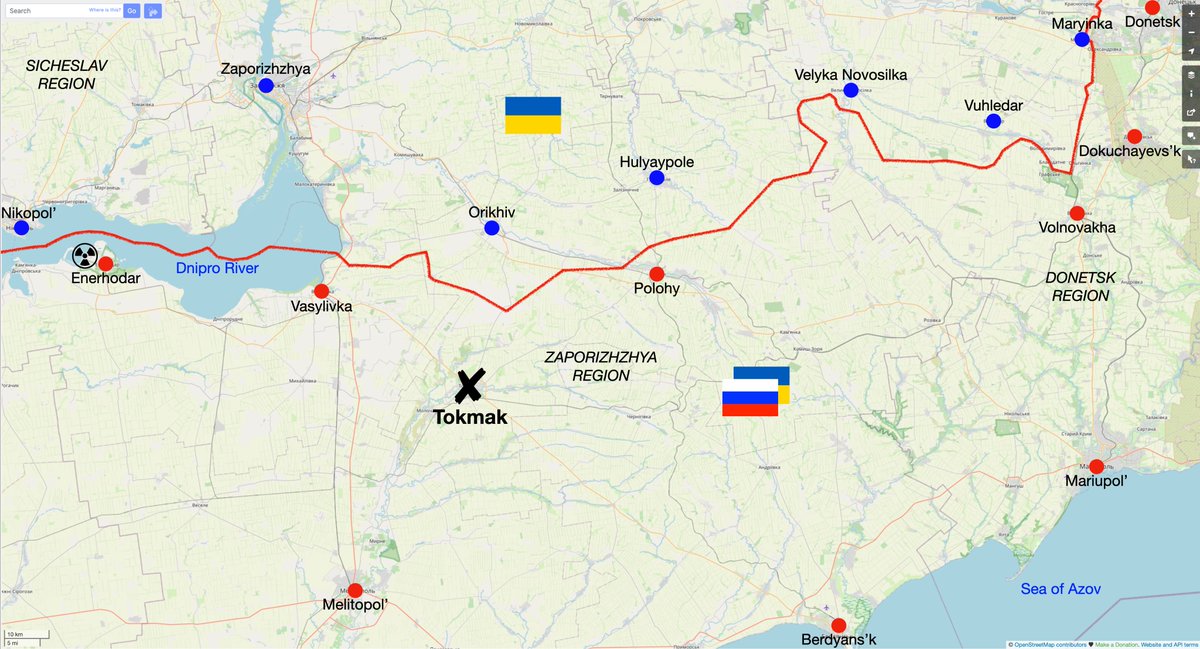
A successful strike here would cut off all means of supplying Russians in Crimea and Kherson.
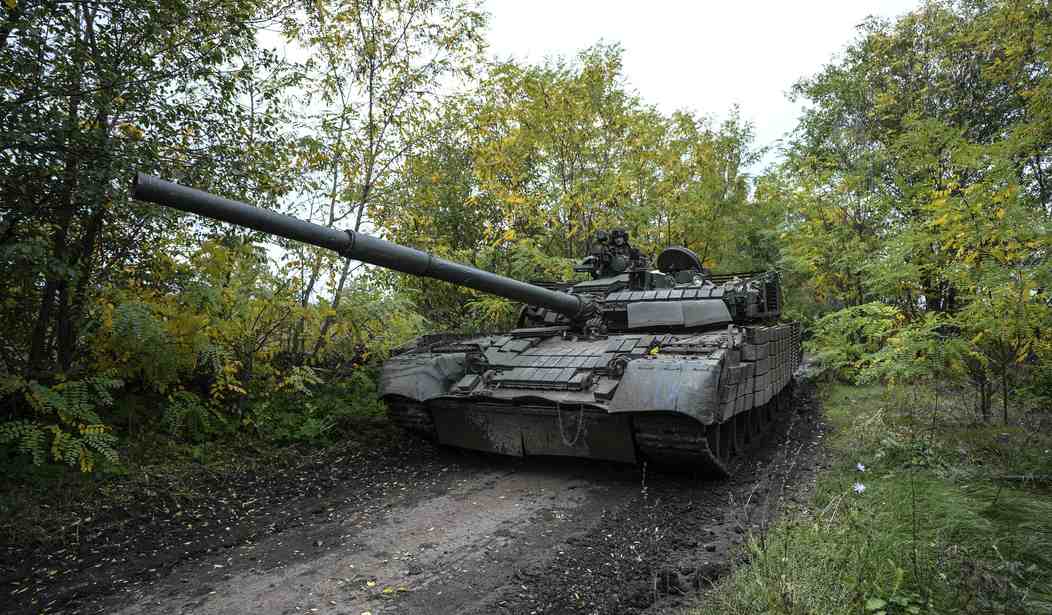
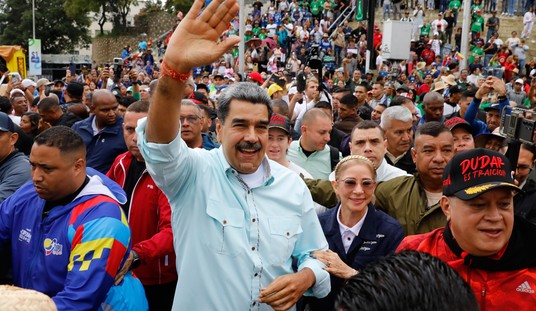


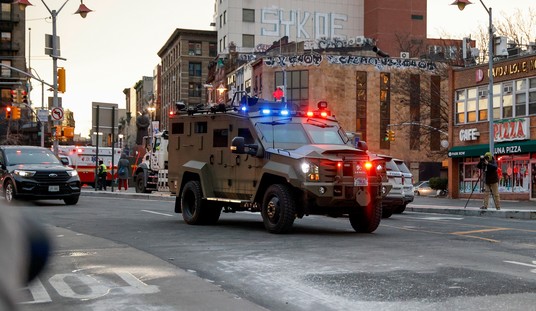






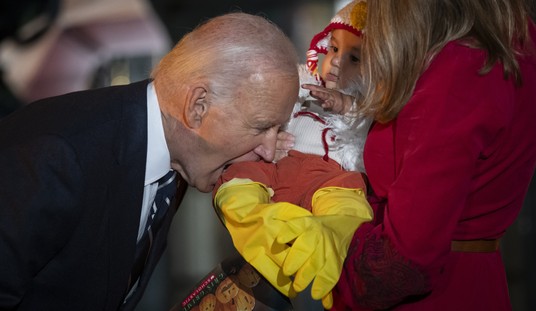


Join the conversation as a VIP Member